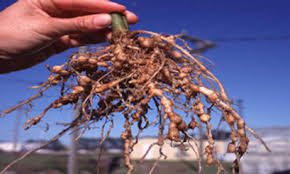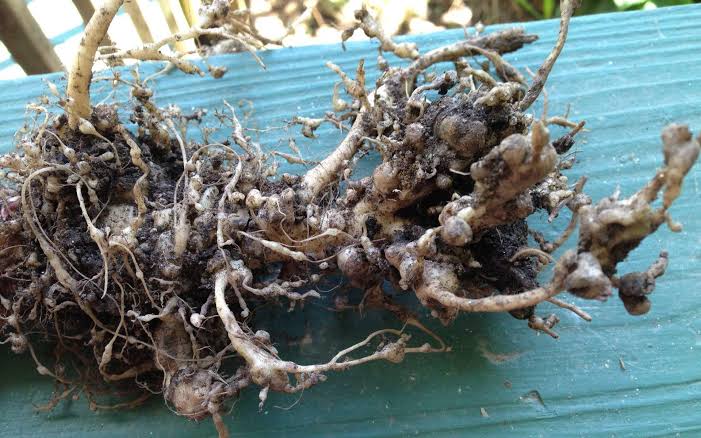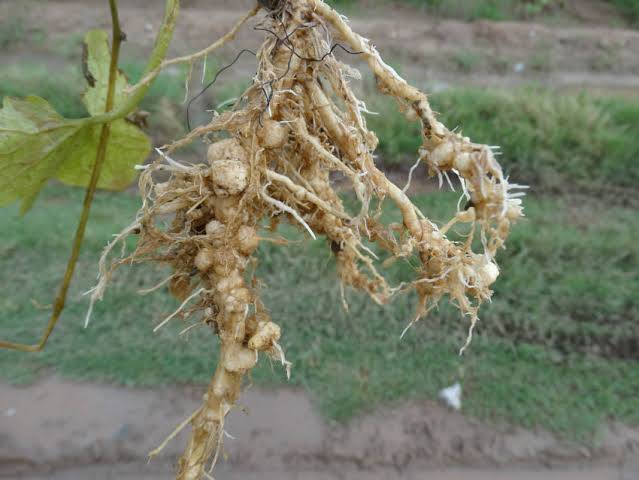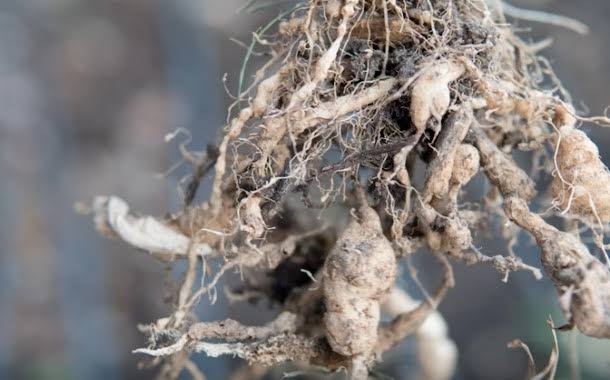Root-knot nematodes, scientifically known as Meloidogyne spp., are microscopic roundworms that can have a significant impact on plants. These tiny pests primarily reside in the soil, where they attach themselves to the roots of various crops and ornamental plants.
These nematodes are renowned for their ability to cause root galls, which are abnormal swellings or knots on the roots of infected plants. The most common species include Meloidogyne incognita, Meloidogyne javanica, and Meloidogyne arenaria. Despite their small size, usually less than 1 mm in length, their impact on agriculture can be substantial.
These pests follow a life cycle that involves several stages, including eggs, juveniles, and adults. The nematode larvae invade the plant roots, forming feeding sites that lead to the development of the characteristic galls. As these nematodes feed on plant tissues, they deprive the plant of essential nutrients, stunting its growth and affecting its overall health.
Farmers face significant challenges in managing root-knot nematodes, as they are persistent in the soil and can survive for extended periods, even in the absence of a host plant. Crop rotation, the use of resistant plant varieties, and soil amendments are among the strategies employed to mitigate their impact.
The economic consequences of root-knot nematode infestations are profound, as affected crops may experience reduced yields and diminished quality. Additionally, the costs associated with nematode control measures contribute to the overall financial burden on farmers.
Research efforts are ongoing to develop sustainable and environmentally friendly methods to control these nematodes. Biological control agents, such as certain fungi and bacteria, show promise in suppressing nematode populations. Integrated pest management (IPM) strategies that combine various control methods are increasingly being adopted to enhance effectiveness while minimizing environmental impact.
In addition, Root-knot nematodes, Meloidogyne spp., pose a formidable threat to agricultural productivity by affecting the roots of a wide range of plants. Efforts to manage these pests involve a combination of cultural, biological, and chemical control measures, with ongoing research aimed at developing sustainable solutions for farmers facing the challenges posed by these microscopic invaders.
Read Also: Redcurrants: History, Nutrition, Health Benefits and Growing Guide
Plants Affected by Root-knot Nematodes (Meloidogyne spp.)

Root-knot nematodes can affect a diverse array of plants, spanning both agricultural crops and ornamental plants. Some of the commonly affected plants include:
1. Tomatoes: Tomato plants are particularly susceptible to root-knot nematode infestations. The nematodes can lead to the formation of galls on the roots, affecting the plant’s ability to take up nutrients and water.
2. Potatoes: Root-knot nematodes pose a threat to potato crops, impacting tuber development and overall yield. Infested plants may exhibit stunted growth and reduced vigor.
3. Carrots: Carrot roots can also fall victim to these nematodes, resulting in deformities and reduced quality. Infestations can lead to economic losses for carrot growers.
4. Bell Peppers: Pepper plants are vulnerable to root-knot nematodes, causing damage to the root system and hindering the plant’s productivity.
5. Okra: Okra plants are among the crops susceptible to nematode infestations. Galls on the roots can impair nutrient uptake, affecting the overall health of the plant.
6. Cucumbers: Cucumber plants may experience decreased growth and yield when affected by root-knot nematodes. The nematodes disrupt the normal functioning of the root system.
7. Strawberries: Root-knot nematodes can impact strawberry plants, leading to root galling and compromising the plant’s ability to produce healthy fruit.
8. Citrus Trees: Certain citrus tree varieties can be affected by root-knot nematodes, causing damage to the root structure and potentially reducing fruit production.
9. Roses: Ornamental plants like roses can also be susceptible to these nematodes. Galls on the roots may affect the aesthetic appeal and overall health of the plants.
10. Beans: Various types of beans, including green beans and soybeans, can be affected by root-knot nematodes, resulting in reduced crop yields.
It’s important for farmers and gardeners to be aware of the plants susceptible to root-knot nematodes in order to implement effective management strategies and minimize the impact of these microscopic pests on crop productivity and plant health.
Damages Caused by Root-knot Nematodes

Root-knot nematodes inflict significant damage on plants, leading to various detrimental effects on their growth, development, and overall health. The damages caused by these nematodes include:
1. Formation of Galls: One of the hallmark effects of root-knot nematode infestation is the formation of galls or knots on the roots of infected plants. These abnormal swellings disrupt the normal structure and function of the root system.
2. Stunted Growth: Nematode feeding on the roots interferes with the plant’s ability to take up water and nutrients. This, in turn, results in stunted growth and reduced overall plant vigor.
3. Reduced Yield: Crop plants affected by root-knot nematodes often experience a decrease in yield. The nematodes compromise the plant’s reproductive capabilities, leading to fewer fruits, vegetables, or seeds.
4. Nutrient Deficiency: As root-knot nematodes feed on plant roots, they cause damage to the tissues responsible for nutrient absorption. This disruption can result in nutrient deficiencies, negatively impacting the plant’s physiological processes.
5. Wilting and Yellowing: Infested plants may exhibit symptoms of wilting, even in well-watered conditions. The nematodes contribute to water stress by interfering with the plant’s water uptake. Additionally, affected plants may display yellowing of leaves, a sign of nutrient imbalances.
6. Root Deformation: The presence of root-knot nematodes can lead to the deformation and malformation of plant roots. This alters the normal architecture of the root system and further hinders the plant’s ability to anchor itself and absorb nutrients.
7. Increased Susceptibility to Other Pests and Diseases: Plants weakened by root-knot nematodes become more susceptible to other stresses, including attacks by secondary pests and diseases. This can create a cascade of negative effects on plant health.
8. Economic Losses: Farmers may incur significant economic losses due to reduced crop yields and the costs associated with implementing control measures. The financial impact extends to both small-scale and large-scale agricultural operations.
9. Affecting Ornamental Plants: Root-knot nematodes can also damage ornamental plants, impacting their aesthetic appeal and overall health. This is of concern for gardeners and landscapers.
10. Long-Term Soil Persistence: Root-knot nematodes have the ability to persist in the soil for extended periods, even in the absence of host plants. This makes it challenging to implement effective crop rotation strategies and increases the risk of recurrent infestations.
Understanding the damages caused by root-knot nematodes is crucial for developing and implementing effective management strategies to mitigate their impact on agriculture and horticulture.
Read Also: Huckleberries: History, Nutrition, Health Benefits and Growing Guide
Control and Preventive Measures

Managing root-knot nematodes involves a combination of preventive measures and control strategies. Here are various approaches to control and prevent the impact of these nematodes:
1. Crop Rotation: Rotate crops regularly to disrupt the nematode life cycle. Planting non-host or resistant crops in infested areas can help reduce nematode populations over time.
2. Use of Resistant Varieties: Select and cultivate crop varieties that exhibit resistance or tolerance to root-knot nematodes. This can be an effective way to minimize damage and maintain crop productivity.
3. Nematicide Application: Chemical nematicides can be used to control nematode populations. However, their use should be carefully managed, considering environmental impact and potential harm to non-target organisms.
4. Biological Control: Introduce natural enemies of nematodes, such as certain beneficial nematodes, fungi (like Paecilomyces lilacinus), and bacteria (like Bacillus spp.), to the soil. These organisms can help suppress nematode populations.
5. Cover Crops: Planting cover crops like marigold or mustard can release compounds into the soil that are toxic to nematodes, helping to reduce their numbers.
6. Soil Solarization: Expose the soil to sunlight by covering it with transparent plastic sheets during hot seasons. This solarization process can help reduce nematode populations in the top layers of the soil.
7. Good Agricultural Practices: Implement proper irrigation and drainage practices to maintain optimal soil moisture levels. Well-drained soil reduces the favorable conditions for nematode reproduction.
8. Sanitation: Remove and destroy plant residues, roots, and weeds that may harbor nematodes. This reduces the availability of hosts and limits the nematodes’ ability to survive in the soil.
9. Soil Amendments: Incorporate organic matter into the soil to improve its structure and microbial activity. Healthy soils with diverse microbial communities can suppress nematode populations.
10. Early Detection and Monitoring: Regularly monitor plants for symptoms of nematode infestation, such as galls and stunted growth. Early detection allows for prompt action, reducing the potential for severe damage.
11. Resistant Cover Crops: Some cover crops, like certain brassicas, can release compounds that suppress nematode populations. Integrating these cover crops into rotation plans can be beneficial.
12. Integrated Pest Management (IPM): Adopt an integrated approach that combines various control methods, including cultural, biological, and chemical measures, to manage nematode populations sustainably.
It’s essential to tailor control strategies to specific crops, environmental conditions, and the severity of nematode infestations. Combining multiple approaches in an integrated manner often yields the most effective and sustainable results in managing root-knot nematodes.
Frequently Asked Questions (FAQs) About Root-knot Nematodes (Meloidogyne spp.)
1. Q: What are root-knot nematodes, and how do they affect plants?
A: Root-knot nematodes, scientifically known as Meloidogyne spp., are microscopic roundworms that infest plant roots, causing the formation of galls. These galls disrupt normal root function, leading to stunted growth, reduced vigor, and lower crop yields.
2. Q: Which plants are most susceptible to root-knot nematode infestations?
A: Various crops can be affected, including tomatoes, potatoes, carrots, bell peppers, okra, cucumbers, strawberries, citrus trees, beans, and roses. Ornamental and agricultural plants can both fall victim to these nematodes.
3. Q: How can I identify if my plants are infested with root-knot nematodes?
A: Look for symptoms such as galls or knots on the roots, stunted growth, wilting, yellowing leaves, and root deformation. Regular monitoring is crucial for early detection.
4. Q: What preventive measures can I take to avoid root-knot nematode infestations in my garden?
A: Employ practices like crop rotation, planting resistant varieties, using cover crops, and practicing good sanitation by removing plant residues and weeds.
5. Q: Are there chemical treatments for controlling root-knot nematodes, and how should they be used?
A: Chemical nematicides can be effective, but their use should be judicious due to potential environmental impact. Follow recommended application rates and guidelines, and consider alternative methods for sustainable nematode control.
6. Q: Can beneficial organisms help in controlling root-knot nematode populations?
A: Yes, certain beneficial nematodes, fungi (e.g., Paecilomyces lilacinus), and bacteria (e.g., Bacillus spp.) can act as biological control agents to suppress nematode populations.
7. Q: How long do root-knot nematodes persist in the soil?
A: Root-knot nematodes can survive in the soil for extended periods, even without host plants. This persistence makes long-term management strategies essential.
8. Q: Is there any way to naturally improve soil health to reduce root-knot nematode impact?
A: Yes, incorporating organic matter, practicing proper irrigation, and promoting good soil structure can enhance soil health, creating conditions less favorable for nematode reproduction.
9. Q: Can soil solarization be effective in reducing root-knot nematode populations?
A: Yes, exposing the soil to sunlight through soil solarization can help reduce nematode populations in the top layers of the soil, particularly during hot seasons.
10. Q: What is integrated pest management (IPM), and how can it be applied to control root-knot nematodes?
A: IPM is an approach that combines various control methods, including cultural, biological, and chemical measures, to manage nematode populations sustainably. Tailoring strategies to specific conditions and crops is key to its effectiveness.
Read Also: How to Grow Tomatoes in Containers

